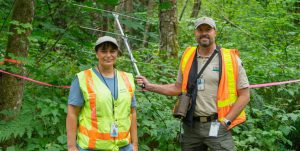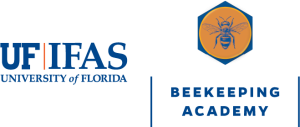Plant Protection Today – PPQ and Washington State Partners Get Ready for Another Hunting Season
PPQ and Washington State Partners Get Ready for Another Hunting Season

In 2021, visiting Oregon Department of Agriculture (ODA), entomologist Jessica Rendon and PPQ’s Plant Health Safeguarding Specialist Stacy Herron tracked a tagged northern giant hornet (NGH) to its nest in record time. The nest, which was successfully eradicated from an Alder tree, contained nearly 1,500 NGH life stages.
Tracking Northern Giant Hornet is An Adventure Like No Other
By Sharon Lucik
This is the final article in a 3-part Plant Protection Today series about the U.S Department of Agriculture’s Plant Protection and Quarantine program and the Washington State Department of Agriculture, and their response to the northern giant hornet (NGH).
The NGH (Vespa mandarinia) is a social wasp species. Its native range extends from northern India to East Asia. This pest was first reported in the Vancouver Island area of Canada in August 2019 and was also detected in Washington State that same year in December.
Most days you can find the U.S. Department of Agriculture’s Plant Protection and Quarantine’s (PPQ’s) Plant Health Safeguarding Specialist Stacy Herron at the U.S.-Canada land border crossing in Blaine, WA, conducting routine agriculture quarantine inspection duties. Other days, Herron is nowhere to be found because he’s hunting with his colleagues from the Washington State Department of Agriculture (WSDA). Not for deer, elk, or black bear. They’re hunting the largest hornet in the world—the northern giant hornet (NGH).
NGH was first detected in 2019, and from the onset Herron has been all in. He attends meetings, sets and monitors traps, responds to public sightings, and helps capture and tag live hornets and track them back to their nest. His enthusiasm and dedication to the work is mirrored by everyone on the team.
“This year the team will set more than 1,000 traps in northern Whatcom County,” said Herron. “Since this is our fourth trapping season, most landowners know what we’re doing and support us. Although we didn’t detect a single northern giant hornet last year, there’s no predicting what this season will bring. If we have a repeat and there are no detections, that means we’ll be one year closer to declaring NGH eradicated.”
The Hunt
According to Herron, the release of a tagged NGH can be exciting, frustrating, and even boring depending on what the hornet does. It may fly to a tree branch, land on the peak of a house, or head into the forest. Whatever path the hornets take, so does the tracking team—keeping the radio signal strong is central to finding their nests.
“We typically use a 3-person tracking team for each hornet release,” Herron said. “All of us carry a hand-held antenna connected to a radio receiver to monitor the tag’s signal, and mobile phones to communicate our location and signal strength. We wear headphones to hear the signal, neon vests so we can see each other in the distance, and ID badges because before we can enter a property, we first need to get permission from the landowners.”
Despite the team’s planning and preparations, they’ve had their share of unexpected challenges. The team found a radio tag in the underbrush that had fallen off the hornet they were tracking. On another occasion, overhead electrical powerlines interfered with the tag’s signal and confounded tracking for hours. And when a tagged hornet crossed the border into Canada, the team had to scramble and hand-off the tracking equipment to a Canadian apiary partner so their efforts could continue—only to have the hornet fly back over the border.
“We do our best and never lose sight of the endgame,” Herron said. “We’re determined and confident, and our track record speaks for itself. Our team has successfully located and eradicated 4 NGH nests, and if there are more nests out there, I’m optimistic that we will find and eliminate them too.”
We are here to share current happenings in the bee industry. Bee Culture gathers and shares articles published by outside sources. For more information about this specific article, please visit the original publish source: USDA APHIS | PPQ and Washington State Partners Get Ready for Another Hunting Season








